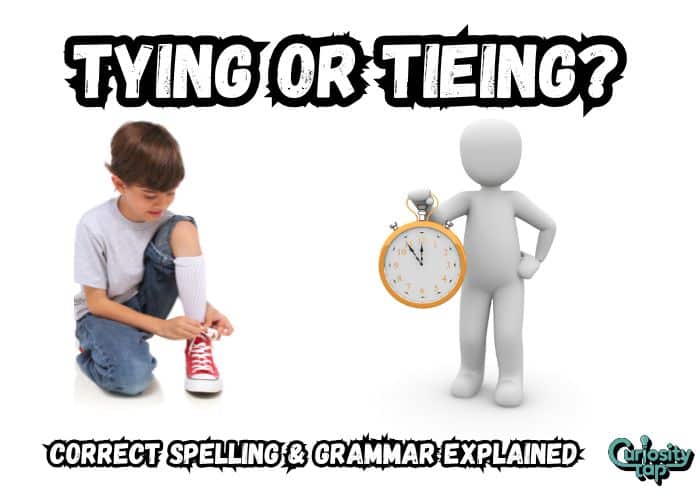Have you ever stopped mid-sentence wondering whether it’s tieing or tying? You’re not alone. This tiny spelling dilemma trips up native and non-native English speakers alike.
Whether you’re writing an email, crafting a blog, or preparing academic work, using the correct form of a word shows command over language and professionalism.
Today, we’ll clear up this common confusion once and for all with grammar rules, real examples, and a quick-reference table so you never have to second-guess again.
Why Do People Confuse “Tying” and “Tieing”?
The confusion between tying and tieing stems from how we form present participles (verbs ending in “-ing”) and apply spelling rules especially when a verb ends in -e.
The Base Verb: “Tie”
The verb “tie” means to fasten or secure with a string, cord, or rope. Common uses include:
- Tying your shoes
- Tying a knot
- Tying a game
So why isn’t “tieing” correct?
The Grammar Rule: Drop the ‘E’ Before Adding ‘-ing’
According to standard English grammar conventions:
If a verb ends in “-e,” you drop the ‘e’ before adding “-ing.”
Example: make → making, bake → baking
Tie → tying (not tieing)
Is “Tieing” Ever Correct?
No, “tieing” is not recognized as a standard or alternative spelling in modern English dictionaries like Merriam-Webster or the Oxford English Dictionary.
A few outdated texts or informal digital content may use “tieing,” but it is grammatically incorrect and should be avoided in all forms of formal or academic writing.
✅ Correct: Tying
❌ Incorrect: Tieing
Also Read: Cancelation or Cancellation: Which Spelling is Correct?
Real-World Example: The Day I Misspelled “Tying” in a Press Release
Back in 2018, I was writing a press release for a client in the fashion industry. We were launching a new line of handcrafted shoelaces, and in the draft, I wrote:
“Our collection celebrates the art of tieing laces with flair.”
An editor flagged it instantly. I was surprised wasn’t “tieing” logical?
That tiny spelling slip nearly went to print. Had it gone out, it could’ve impacted the brand’s credibility. This taught me a vital lesson: in English, even logical spellings aren’t always correct. Grammar rules > intuition.
Tying vs Tieing: Quick Comparison Table
| Aspect | Tying (✅ Correct) | Tieing (❌ Incorrect) |
|---|---|---|
| Verb root | Tie | Tie |
| Follows grammar rule | Yes | No |
| Used in dictionaries | Yes | No |
| Professional usage | Yes | Never |
| Real-world accepted | Yes | No |
How to Avoid This Mistake in the Future
1. Remember the “Silent E” Rule
When a verb ends in -e, drop the e before adding -ing.
2. Use Spellcheck But Verify
Tools like Grammarly, Microsoft Word, and Google Docs will flag tieing as a misspelling but always cross-check for context.
FAQs: People Also Ask
1. Is “tieing” a word in any English dialect?
No, it is not recognized in British, American, or Australian English.
2. What’s the past tense of “tie”?
Tied is the correct past tense.
Example: He tied his shoelaces before leaving.
3. How do you pronounce “tying”?
It’s pronounced /ˈtaɪ.ɪŋ/ rhyming with “crying.”
4. Are there other verbs like “tie” that drop the ‘e’?
Yes! Examples include:
- Lie → lying
- Die → dying
- Bake → baking
5. Is “tying” ever used metaphorically?
Absolutely! Example:
“She’s tying herself emotionally to a toxic situation.”
6. Can “tieing” ever be a typo in coding or software?
It may appear due to poor spellcheck, but it’s still incorrect from a linguistic standpoint.
Pros and Cons: Learning Language Through Rules vs Intuition
| Learning Method | Pros | Cons |
|---|---|---|
| Rule-based learning | Accurate, helps avoid mistakes | Takes time to memorize |
| Intuitive learning | Feels natural | Can lead to errors like “tieing” |
| Combination approach | Balanced, effective, long-lasting | Requires effort and regular correction |
Conclusion: Mastering the Basics Makes You a Stronger Writer
When it comes to language, details matter. Using the correct word lke tying instead of tieing shows precision, professionalism, and care. By applying the simple “drop the e” rule, you can avoid this common mistake every time.
Before you hit “send” or “publish,” give your writing a quick scan for common errors like this one. Little improvements like these go a long way.
Sources
Sources:
- Merriam-Webster. (n.d.). Definition of Tying. Retrieved July 19, 2025, from https://www.merriam-webster.com/dictionary/tying
- Oxford English Dictionary. (n.d.). Tying. Retrieved July 19, 2025, from https://www.oed.com/
- Grammarly Blog. (2023). Words ending in e: When to drop the final e. https://www.grammarly.com/blog/words-ending-in-e/
Read more knowledgeable blogs on Curiosity Tap
Is this article helpful?

Jackson Pearson is a passionate educator and language enthusiast behind the blog Jackson Pearson. With years of experience in teaching and writing, he specializes in simplifying complex grammar rules, breaking down tricky vocabulary, and crafting learning guides that are both engaging and practical. His mission is to help readers boost their English skills whether they’re beginners or brushing up for fluency. Through every article, Jackson brings clarity, structure, and a spark of curiosity to the world of English learning.



